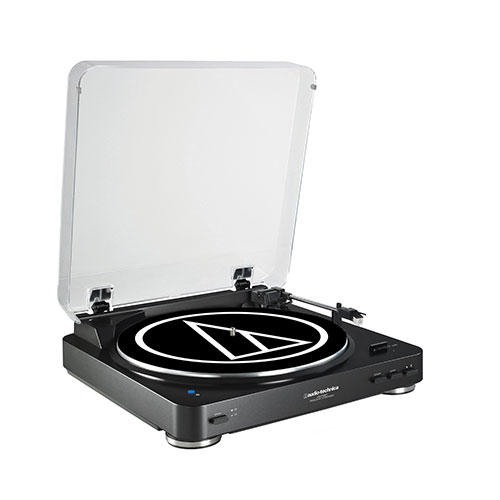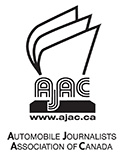|
|
||||
Setup is easy, as is pairing via the Bluetooth button near the front left corner of the base. There's also a switch on the rear panel to differentiate between the internal and external phono preamps.
As I mentioned when I previewed the turntable a couple of months back, the big advantage of using Bluetooth connection is that you can spin your vinyl tunes to your wireless speaker systems, whether they happen to be a sound bar or a portable speaker: if it's Bluetooth it should work. I tried it with a couple of different Bluetooth speaker and it worked fine every time.
This adds a nice bit of portability to the turntable, because you can play your vinyl to wherever (within range) the speaker is. I enjoyed trying this but when push came to shove, I realized that streaming to a wireless speaker is better done from a smart device if only for the reason that you don't have to run back to the turntable at the end of the record's side to turn it over.
Sure, the automatic turntable will shut itself off when the record is over, but if you want more music to play you're sure to be exercised better than if you had a treadmill!
The turntable is available in black, white, or navy, and handles 33-1/3 and 45 rpm records (I didn't have an 45's left to try, but have no reason to question the turntable's capability here). Audio-Technica says it will remember up to eight different Bluetooth devices as well, so you have plenty of options for musical destinations.
I must admit it seemed a tad weird to hear coming through the Bluetooth speaker the "thunk" of the tonearm touching down and the hiss, wow and flutter that never made their way to the digital realm. That's the nature of the turntable beast, though.
Sounding out the turntable…
I tried the turntable with all of its output options and was surprised to note that it played loudest via Bluetooth. What wasn't a surprise was that the analogue outputs sounded the best, though I really had to crank the audio system to take advantage of them.
Even with Bluetooth, the output volume was very low and if I wanted a listening volume comparable to what I could get from a digital file version of the tune, I had to crank the audio system nearly to its maximum, at which time the turntable started feeding back through the system. That was very counterproductive. I also noticed that I had to keep the turntable's dust cover lid up or it would vibrate against the base to beat the band, and those vibes would also go through to the audio system.
As for the Bluetooth interface not sounding as good as the analogue ones, despite it being louder, when I inquired about the USB interface omission and whether or not a customer could use Bluetooth to connect to a computer for ripping your vinyl the folks at Audio-Technica responded thusly:
"Bluetooth was designed to be used as a method of wireless audio playback, not for recording purposes. As far as we know, there is not a recording software program that is capable of detecting/selecting a Bluetooth connection as a recording input device. Also, it is known in the audio world that Bluetooth connections do not provide the same audio quality as using a wired connection. Considering when recording you will want to capture the highest quality audio possible, it is not recommended to record with a wireless connection as compared to wired."
So there. You can forget about ripping your vinyl with this turntable.
I had some good source material to try when reviewing the turntable, old records that I for some reason hadn't yet gotten rid of - and now that I realize I still have them I won't get rid of them so I can use them for the next turntable review that comes along. And since I had three of the albums (which were, fortunately and surprisingly, in mint condition after all these years) in digital versions as well (either CD or FLAC files or SACD disc), it made for a pretty good apples-to-apples comparison.
The best comparison came from my Mobile Fidelity Sound Labs half speed mastered Ultradisc vinyl version of Pink Floyd's The Dark Side of the Moon. It was great hearing this classic on vinyl again, and it sounded cleaner and less "edgy" than the digital versions. But the digital FLAC files, while sounding a little harsher than the vinyl, had much more presence and were much louder than the vinyl when played at the same volume.
After I set my OPPO BDP-105 SACD player to play in stereo rather than in 5.1 I slid the DSOTM disc into it, and it played back even louder and more dynamically than the FLAC files - but it also had a harder edge to it than the vinyl version.
I also tried Pink Floyd's Animals and Wish You Were Here, both of which had also remained in mint condition since I bought them upon their initial release. Animals sounded very good on vinyl, via Bluetooth, better than original and thin-sounding "unremastered" CD. Playing the album via the analogue outputs made it sound very thin and quiet (again, using the same volume on the preamp for each version). I also tried a digital file I ripped from vinyl years ago, and it was louder and more involving - though it was also a tad harsher.
It was the same story for Wish You Were Here.
Many audiophiles (well, some anyway) swear that analogue vinyl records still sound better than the digital versions and I must admit that if all things were equal (playback volume, file format, etc.) they could have a case: in my tests, the best sound quality did indeed come from the vinyl versions. Alas, the most listenable sound levels came from digital, and the digital files didn't feed back regardless of the volume at which I played them.
So while I enjoyed listening to the mellower sound of the vinyl, I didn't prefer it enough to make me want try recreating my formerly formidable vinyl library. I also missed the easy track access and the flexibility you can get from digital discs and files, as well as their tiny "footprint" (no 12 x 12 inch spaces necessary for a digital album).
I also didn't miss the rumble, wow and flutter I'd lived with in the past, which is the nature of the vinyl playback beast, nor did I miss having to flip discs over half way through.
Guess I'm a digital guy at heart now. Now if they could just get the digital files to sound as good as they do on vinyl (and sometimes they do), it would be a real win-win for everyone except the turntable manufacturers.
Copyright 2017 Jim Bray
TechnoFile.com
Jim Bray's columns are available through the TechnoFile Syndicate.

 Audio-Technica cuts the cords on turntables
Audio-Technica cuts the cords on turntables